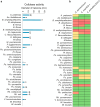Uncovering the antifungal activities of wild apple-associated bacteria against two canker-causing fungi, Cytospora mali and C. parasitica
- PMID: 38491079
- PMCID: PMC10943224
- DOI: 10.1038/s41598-024-56969-4
Uncovering the antifungal activities of wild apple-associated bacteria against two canker-causing fungi, Cytospora mali and C. parasitica
Abstract
Cytospora canker has become a devastating disease of apple species worldwide, and in severe cases, it may cause dieback of entire trees. The aim of this study was to characterize the diversity of cultivable bacteria from the wild apple microbiota and to determine their antifungal ability against the canker-causing pathogenic fungi Cytospora mali and C. parasitica. Five bacterial strains belonging to the species Bacillus amyloliquefaciens, B. atrophaeus, B. methylotrophicus, B. mojavensis, and Pseudomonas synxantha showed strong antagonistic effects against pathogenic fungi. Therefore, since the abovementioned Bacillus species produce known antifungal compounds, we characterized the antifungal compounds produced by Ps. synxantha. Bacteria grown on nutritional liquid medium were dehydrated, and the active compound from the crude extract was isolated and analysed via a range of chromatographic processes. High-performance liquid chromatography, mass spectrometry, and nuclear magnetic resonance analyses revealed a bioactive antifungal compound, phenazine-1-carboxylic acid (PCA). The minimum inhibitory concentration (MIC) demonstrated that PCA inhibited mycelial growth, with a MIC of 10 mg mL-1. The results suggested that PCA could be used as a potential compound to control C. mali and C. malicola, and it is a potential alternative for postharvest control of canker disease.
Keywords: Pseudomonas synxantha; Antifungal compound; Apple disease; Pathogenic fungi; Phenazine.
© 2024. The Author(s).
Conflict of interest statement
The authors declare no competing interests.
Figures






References
-
- Lin, P. & Lin, Y. In Wild Fruit Forests Resources in Tianshan Mountains-Comprehensive Research on Wild Fruit Forests in Ili, Xinjiang, China (eds P. Lin & N. Cui) 46–62 (China Forestry Publishing House, 2000).
-
- Richards CM, et al. Genetic diversity and population structure in Malus sieversii, a wild progenitor species of domesticated apple. Tree Genet. Genomes. 2009;5:339–347. doi: 10.1007/s11295-008-0190-9. - DOI
MeSH terms
Substances
Supplementary concepts
Grants and funding
LinkOut - more resources
Full Text Sources

